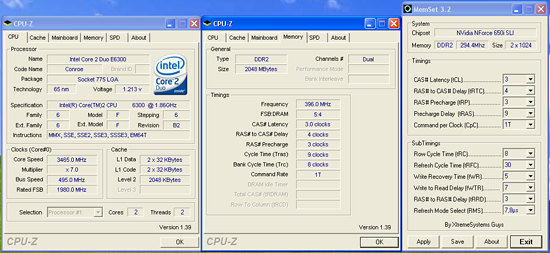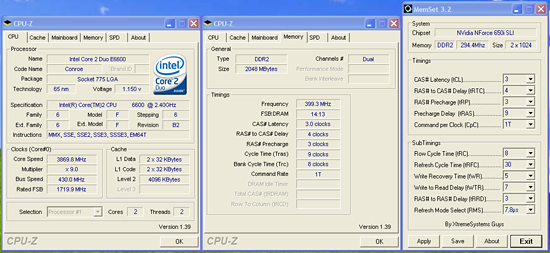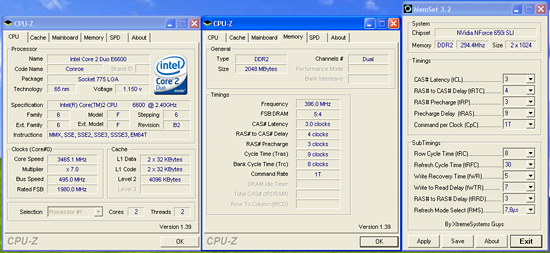ASUS P5N32-E SLI Plus: NVIDIA's 650i goes Dual x16
by Gary Key on April 2, 2007 3:30 AM EST- Posted in
- Motherboards
Overclocking - E6300
We were able to reach a final benchmark stable setting of 7x495 FSB resulting in a clock speed of 3465MHz. We were able to run our OCZ Flex PC2-9200, OCZ Flex PC2-6400, and our Corsair PC2-8888 at the reported timings with a 1T Command Rate enabled with 2.250V. When overclocking we were able to run our standard OCZ Flex PC2-6400 at 1T command rates with very aggressive sub-timings. Vdroop was very good on this board during E6300 overclocking with an average drop of .02V during load testing with our E6300.
Testing with our new OCZ Flex PC2-6400 CAS3 (standard memory installed) and G.Skill F2-6400CL4D-2GBHK modules based on ProMOS IC chips resulted in great success on this board. The OCZ Flex PC2-6400 was able to run up to DDR2-850 speeds with timings at 3-4-3-9 1T at 2.250V and the G.Skill F2-6400CL4D at 4-3-3-9 1T at 2.20V. The remaining memory timings are set to Auto as is standard in our testing and manually adjusting these timings resulted in increased stability while overclocking while minimally decreasing performance in certain games and applications that are memory sensitive. We did notice in 4GB testing that we had to change our OCZ Flex PC2-6400 CAS3 memory timings to 3-4-4-10 2T at 2.275V for stable 24/7 operation in a variety of applications.
Overclocking - E6600
After trying numerous voltages and memory timings we discovered our 9x430 FSB setting was the limit for both our board and CPU. This resulted in a final clock speed of 3869MHz at 1.4750V which is the limit for our Tuniq 120 air cooler. We did find the typical FSB hole around 416FSB but did not notice the same issues we had with the 680i LT SLI having several FSB ranges that were unusable. We were able to post and complete benchmark testing at 435FSB but could not pass dual Prime95 at that setting. Vdroop was very acceptable but not great during overclocking with an average drop of .03V ~ .04V during load testing with our E6600. We generally found that without decent airflow around the CPU and memory locations that our maximum FSB was near 408 with this configuration.
We dropped the multiplier on our E6600 to seven and were able to reach the same 495 FSB level as with the E6300. We were able to enter XP at 7x515 but the board was not stable, and we could complete all benchmarks at 7x510 except for dual Prime95. At first we thought the board was locked at 500FSB but once again we found FSB holes but this time they ranged from 502 to 516. We noticed in overclock testing that we were able to extract an 1133 memory speed at 5-5-4-15 2T timings at 2.20V with our OCZ Flex PC2-6400. This matches the 680i LT SLI speeds at slightly better timings although performance differences were minimal with sub-timings set the same. We dropped in our OCZ Flex PC2-9200 and Corsair PC2-9136 modules with both being able to reach DDR2-1275 but at 5-5-5-18 timings compared to the 5-5-4-12 2T timings at 2.30V on the 680i LT SLI board. Memory performance and stability was superb once the board was dialed in.
| ASUS P5N32-E SLI Plus Dual Core Overclocking |
|
| Processor: | Intel Core 2 Duo E6300 Dual Core, 1.86GHz, 2MB Unified Cache 1066FSB, 7x Multiplier |
| CPU Voltage: | 1.4500V (default 1.3250V) |
| NB Voltage: | 1.45V |
| 1.2V HTT Voltage: | 1.40V |
| SB Voltage: | 1.50V |
| CPU VTT: | 1.25V |
| Cooling: | Tuniq 120 Air Cooling |
| Power Supply: | OCZ ProXStream 1000W |
| Memory: | OCZ Flex XLC PC2-6400 (2x1GB) |
| Video Cards: | 1 x MSI 8800GTX |
| Hard Drive: | Western Digital 150GB 10, 000RPM SATA 16MB Buffer |
| Case: | Cooler Master CM Stacker 830 |
| Maximum OC: | 495x7 (3-4-3-9 1T, 792MHz, 2.250V), CPU 1.4500V 3465MHz (+86% FSB/CPU) |
| . | |
 |
| Click to enlarge |
We were able to reach a final benchmark stable setting of 7x495 FSB resulting in a clock speed of 3465MHz. We were able to run our OCZ Flex PC2-9200, OCZ Flex PC2-6400, and our Corsair PC2-8888 at the reported timings with a 1T Command Rate enabled with 2.250V. When overclocking we were able to run our standard OCZ Flex PC2-6400 at 1T command rates with very aggressive sub-timings. Vdroop was very good on this board during E6300 overclocking with an average drop of .02V during load testing with our E6300.
Testing with our new OCZ Flex PC2-6400 CAS3 (standard memory installed) and G.Skill F2-6400CL4D-2GBHK modules based on ProMOS IC chips resulted in great success on this board. The OCZ Flex PC2-6400 was able to run up to DDR2-850 speeds with timings at 3-4-3-9 1T at 2.250V and the G.Skill F2-6400CL4D at 4-3-3-9 1T at 2.20V. The remaining memory timings are set to Auto as is standard in our testing and manually adjusting these timings resulted in increased stability while overclocking while minimally decreasing performance in certain games and applications that are memory sensitive. We did notice in 4GB testing that we had to change our OCZ Flex PC2-6400 CAS3 memory timings to 3-4-4-10 2T at 2.275V for stable 24/7 operation in a variety of applications.
Overclocking - E6600
| ASUS P5N32-E SLI Plus Dual Core Overclocking |
|
| Processor: | Intel Core 2 Duo E6600 Dual Core, 2.4GHz, 4MB Unified Cache 1066FSB, 9x Multiplier |
| CPU Voltage: | 1.4750V / 1.4500 (default 1.3250V) |
| NB Voltage: | 1.45V |
| 1.2V HTT Voltage: | 1.45V |
| SB Voltage: | 1.50V |
| CPU VTT: | 1.35V / 1.30V |
| Cooling: | Tuniq 120 Air Cooling |
| Power Supply: | OCZ ProXStream 1000W |
| Memory: | OCZ Flex XLC PC2-6400 (2x1GB) |
| Video Cards: | 1 x MSI 8800GTX |
| Hard Drive: | Western Digital 150GB 10, 000RPM SATA 16MB Buffer |
| Case: | Cooler Master CM Stacker 830 |
| Maximum CPU OC: | 430x9 (3-4-3-9 1T, 799MHz, 2.25V), CPU 1.4750V 3869MHz (+61%) |
| Maximum FSB OC: | 495x7 (3-4-3-9 1T, 792MHz, 2.25V), CPU 1.4500V 3465MHz (+86% FSB) |
| . | |
 |
| Click to enlarge |
After trying numerous voltages and memory timings we discovered our 9x430 FSB setting was the limit for both our board and CPU. This resulted in a final clock speed of 3869MHz at 1.4750V which is the limit for our Tuniq 120 air cooler. We did find the typical FSB hole around 416FSB but did not notice the same issues we had with the 680i LT SLI having several FSB ranges that were unusable. We were able to post and complete benchmark testing at 435FSB but could not pass dual Prime95 at that setting. Vdroop was very acceptable but not great during overclocking with an average drop of .03V ~ .04V during load testing with our E6600. We generally found that without decent airflow around the CPU and memory locations that our maximum FSB was near 408 with this configuration.
 |
| Click to enlarge |
We dropped the multiplier on our E6600 to seven and were able to reach the same 495 FSB level as with the E6300. We were able to enter XP at 7x515 but the board was not stable, and we could complete all benchmarks at 7x510 except for dual Prime95. At first we thought the board was locked at 500FSB but once again we found FSB holes but this time they ranged from 502 to 516. We noticed in overclock testing that we were able to extract an 1133 memory speed at 5-5-4-15 2T timings at 2.20V with our OCZ Flex PC2-6400. This matches the 680i LT SLI speeds at slightly better timings although performance differences were minimal with sub-timings set the same. We dropped in our OCZ Flex PC2-9200 and Corsair PC2-9136 modules with both being able to reach DDR2-1275 but at 5-5-5-18 timings compared to the 5-5-4-12 2T timings at 2.30V on the 680i LT SLI board. Memory performance and stability was superb once the board was dialed in.










37 Comments
View All Comments
yacoub - Sunday, April 29, 2007 - link
Just curious about the audio CPU usage test usually done on boards...Leinad - Tuesday, April 3, 2007 - link
In the FAQ for this board on the Asus website, the board is listed as a 680i board. Newegg lists it as a 650i board, and Anandtech likewise calls it a 650i board. Nice to finally see an explanation.Looking forward to the Motherboard roundup!
goinginstyle - Thursday, April 5, 2007 - link
Any chance of testing some cheap memory?sWORDs - Tuesday, April 3, 2007 - link
I'm really disappointed by this review, it's not up to the usual Anandtrch quality. Let me explain why:You can not call this a 650, because there is no nForce 430 southbridge.
Calling the southbridge a AMD570 is a bit misleading, because NB 570AMD = NB 590AMD = SB 590AMD = SB 590i = SB 680i.
Further more there might not even be a difference in the northbridge even if it has 8 lanes disabled, those aren't connected with the "real" 680i's either. They appear as a hidden link, the links on the Hybrid also have a missing #1 port, so it's there, not sure if it's cut or disabled. The only bord that appears to use it isn't here yet, it's the MSI Diamond with 4 PEG ports.
Besides this, you failed to notice that the pcb is actually a Striker Extreme (just peak under de Plus sticker). So any difference between this bord and a Striker Extreme are caused by difference of Bios, or between individual bords. You can't compare one Striker and one Plus and One Evga and make chipset conclussions, two Strikers might end up on different FSB speeds.
"680i SLI chipset utilizes the nForce 590 SLI MCP and 680i SLI MCP." That should be 680i SPP.
Memory timing differences should be caused by bios difference. THe Striker has a 1004 bios ready did you use that?
Dainas - Tuesday, April 3, 2007 - link
Great, so theirs only one PCI slot(rendered useless if you SLI) and the only PCIe 1x is rendered useless if you put a decent videocard in this machine.Not that any friggin SLI/Crossfire LGA board on the market can be considered much better should you want to have more than a soundcard installed.
sWORDs - Tuesday, April 3, 2007 - link
It has two PCI slots and only one would useless when using SLI with double sized cards. The only PCIe 1x is useless when using a double sized card.yacoub - Tuesday, April 3, 2007 - link
Btw this board gets some horrid reviews over on NewEgg. Sure, the user reviews there are known to be pretty tough because anytime someone has a bad experience they're ten times more likely to write about it than someone who has a good experience. But still, compare the reviews of this board with the reviews of the MSI board Anandtech reviewed last week.I wouldn't consider buying this Asus board seeing how many DOAs and other problems folks are reporting with it. The MSI, which doesn't overclock as well, seems much more likely to at least be a 100% functioning product.
How sad that the motherboard market has become this unreliable. I remember when Asus was a board you'd pay just a little more for because it would be solid.
kilkennycat - Monday, April 2, 2007 - link
.. 0501 has an extensive list of 23 fixes over 0402 !!The current latest is 0602 BETA.
See the Asus website. Make sure that you search for the PLUS version of the P5N32E-SLI.
Tuffrabbit - Monday, April 2, 2007 - link
It is interesting that the "budget" 650i board draws a whopping 47 more watts at idle than even the Flagship D975 Intel board ???Tuffrabbit - Monday, April 2, 2007 - link
Correction: Make that 57 watts...